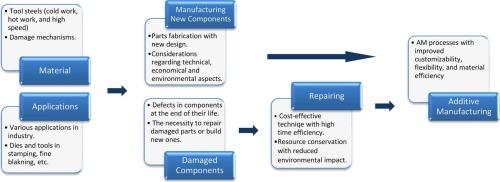Tool steels and their additive manufacturing for fabrication and repair via PBF and DED processes: techniques, challenges, and applications
IF 7.9
2区 材料科学
Q1 MATERIALS SCIENCE, MULTIDISCIPLINARY
引用次数: 0
Abstract
This review investigates the state of additive manufacturing (AM) of tool steels with a clear, process-aware scope that centers on two dominant AM routes, direct energy deposition (DED) and powder bed fusion (PBF), and their respective roles in fabrication and repair. First, different categories of tool steels and their common damage mechanisms are introduced. The distinct process mechanisms, material responses, and performance metrics characteristic of each technique is outlined, and then how microstructure, residual stresses, porosity, and carbide chemistry emerge under DED and PBF processes for different type of alloys are explained. By contrasting process-specific challenges, such as larger melt pools and intrinsic tempering in DED versus rapid solidification and fine microstructures in PBF, with end-use requirements, e.g. wear resistance, toughness, and reliability in tooling, we reveal common optimization approaches, preheating strategies, parameter windows, post-processing heat treatments, and robust non-destructive evaluation are delineated in this work. The review also assesses the material compatibility, challenges, and economic and environmental considerations of AM tooling, and highlights gaps where cross-process insights can accelerate industrial adoption and discussed future trends. The aim is to provide a coherent, process-aware framework that connects AM physics, materials science, and engineering performance for tool steels.

通过PBF和DED工艺制造和修复的工具钢及其增材制造:技术,挑战和应用
本文综述了工具钢增材制造(AM)的现状,并以两种主要的增材制造路线为中心,即直接能量沉积(DED)和粉末床熔合(PBF),以及它们在制造和修复中的各自作用。首先,介绍了不同类型的工具钢及其常见的损伤机理。概述了每种技术的独特工艺机制、材料响应和性能指标特征,然后解释了不同类型合金在DED和PBF工艺下的微观结构、残余应力、孔隙率和碳化物化学反应。通过对比特定工艺的挑战,例如DED中较大的熔池和固有回火与PBF中的快速凝固和精细显微组织,以及最终用途要求,例如工具的耐磨性,韧性和可靠性,我们揭示了常见的优化方法,预热策略,参数窗口,后处理热处理以及稳健的非破坏性评估。该评论还评估了增材制造工具的材料兼容性、挑战以及经济和环境考虑因素,并强调了跨过程洞察力可以加速工业采用的差距,并讨论了未来趋势。其目的是提供一个连贯的、过程感知的框架,将增材制造物理、材料科学和工具钢的工程性能联系起来。
本文章由计算机程序翻译,如有差异,请以英文原文为准。
求助全文
约1分钟内获得全文
求助全文
来源期刊

Materials & Design
Engineering-Mechanical Engineering
CiteScore
14.30
自引率
7.10%
发文量
1028
审稿时长
85 days
期刊介绍:
Materials and Design is a multi-disciplinary journal that publishes original research reports, review articles, and express communications. The journal focuses on studying the structure and properties of inorganic and organic materials, advancements in synthesis, processing, characterization, and testing, the design of materials and engineering systems, and their applications in technology. It aims to bring together various aspects of materials science, engineering, physics, and chemistry.
The journal explores themes ranging from materials to design and aims to reveal the connections between natural and artificial materials, as well as experiment and modeling. Manuscripts submitted to Materials and Design should contain elements of discovery and surprise, as they often contribute new insights into the architecture and function of matter.
 求助内容:
求助内容: 应助结果提醒方式:
应助结果提醒方式:


